Predictions & Data for this entry
| Model: abj | climate: MB, MC | migrate: Mo | phylum: |
| COMPLETE = 3.5 | ecozone: MAE | food: bjPz, jiCi, jiCvf | class: |
| MRE = 0.126 | habitat: 0jMp, jiMcd | gender: D | order: |
| SMSE = 0.027 | embryo: Mp | reprod: O | family: |
Zero-variate data
| Data | Observed | Predicted | (RE) | Unit | Description | Reference |
|---|---|---|---|---|---|---|
| ah_15 | 3.6 | 3.907 | (0.08532) | d | age at hatch | LikaKooy2014 |
| ah_17 | 2.9 | 3.227 | (0.1126) | d | age at hatch | Papa2012 |
| tb_16 | 9 | 8.009 | (0.1101) | d | time since hatch at birth | Papa2012 |
| tb_19 | 7 | 6.028 | (0.1388) | d | time since hatch at birth | LikaKooy2014 |
| tj | 70 | 72.5 | (0.03572) | d | time since hatch at metam | LikaKooy2014 |
| am | 5475 | 5490 | (0.002783) | d | life span | fishbase |
| Lh | 0.35 | 0.2167 | (0.3807) | cm | total length at hatch | LikaKooy2014 |
| Lb | 0.55 | 0.4867 | (0.1151) | cm | total length at birth | LikaKooy2014 |
| Lj | 4 | 3.545 | (0.1137) | cm | total length at metam | LikaKooy2014 |
| Li | 103 | 125.4 | (0.2172) | cm | ultimate total length | fishbase |
| Wwb | 0.00043 | 0.0005469 | (0.2717) | g | wet weight at birth | fishbase |
| Wwp | 700 | 708.9 | (0.01264) | g | wet weight at puberty | Anon2008 |
| Wwi | 1e+04 | 9347 | (0.06534) | g | ultimate wet weight | fishbase |
Uni- and bivariate data
| Data | Figure | Independent variable | Dependent variable | (RE) | Reference |
|---|---|---|---|---|---|
| TJN | 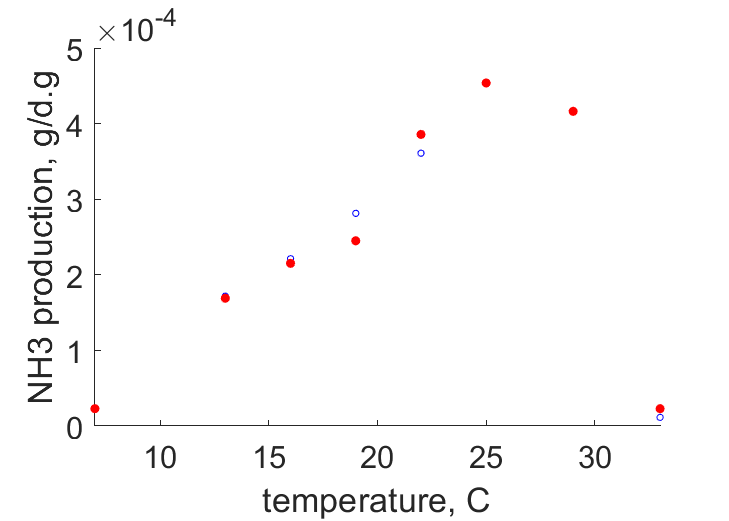 | temperature | NH3 production | (0.04853) | PersMahe2004 |
| WwJX_T |  | wet weight | feed intake | (0.1374) | Zanu1985 |
| WwR | 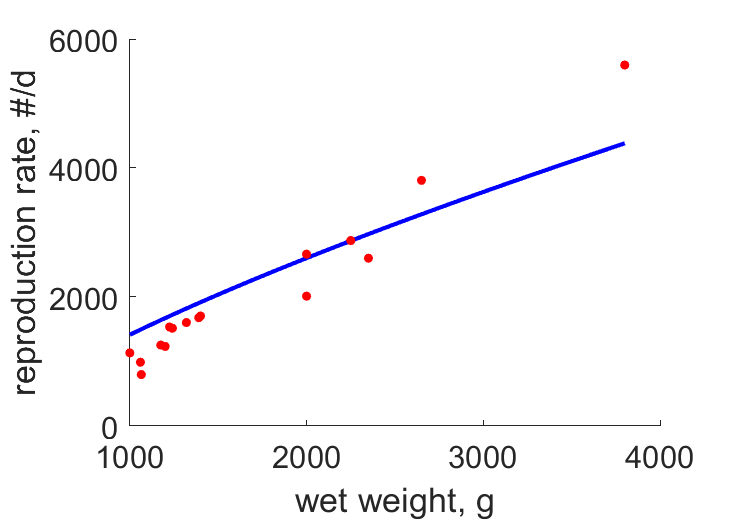 | wet weight | reproduction rate | (0.1857) | MayeShac1990 |
| tL_larv | 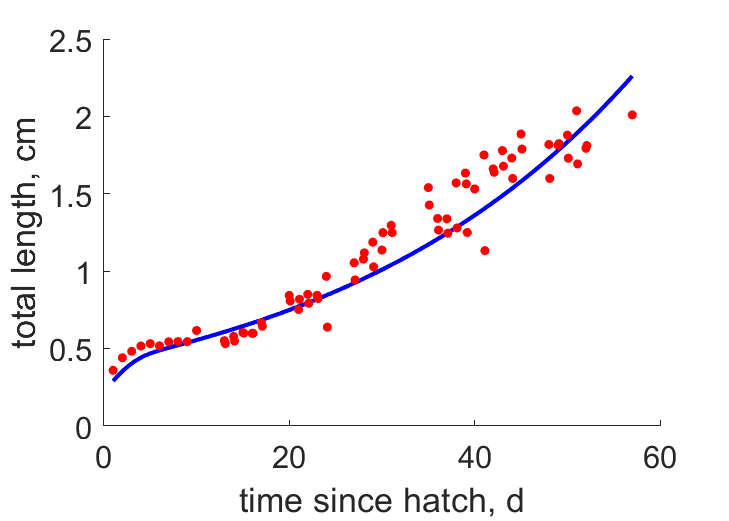 | time since hatch | total length | (0.1052) | LikaPavl2015 |
| tWw | 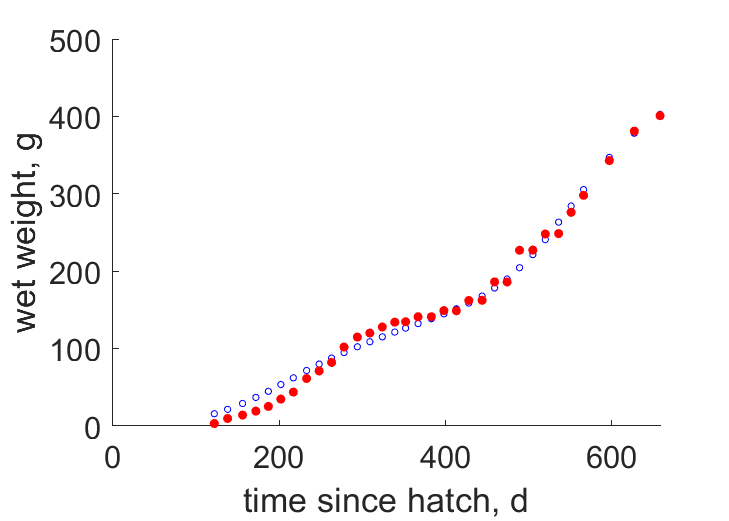 | time since hatch | wet weight | (0.06309) | PapaLika2014 |
| tWw_larv | 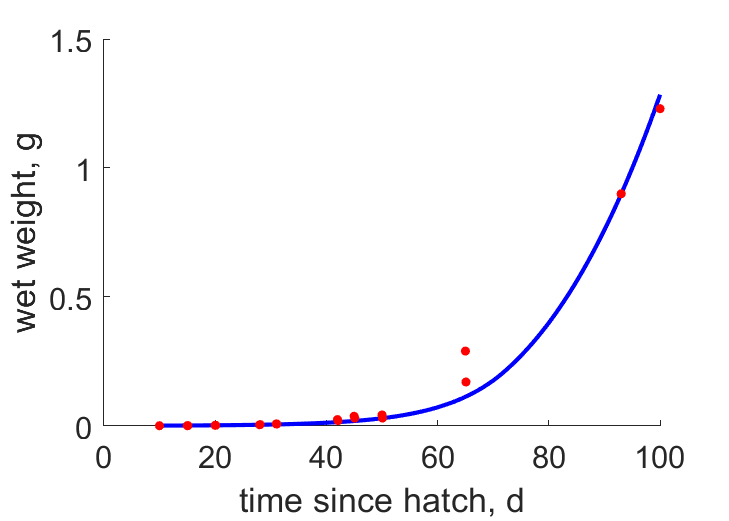 | time since hatch | wet weight | (0.1267) | LikaPavl2015 |
Pseudo-data at Tref = 20°C
| Data | Generalised animal | Dicentrarchus labrax | Unit | Description |
|---|---|---|---|---|
| v | 0.02 | 0.04075 | cm/d | energy conductance |
| p_M | 18 | 18.29 | J/d.cm^3 | vol-spec som maint |
| k_J | 0.002 | 0.002 | 1/d | maturity maint rate coefficient |
| k | 0.3 | 0.572 | - | maintenance ratio |
| kap | 0.8 | 0.6064 | - | allocation fraction to soma |
| kap_G | 0.8 | 0.8 | - | growth efficiency |
| kap_R | 0.95 | 0.95 | - | reproduction efficiency |
Discussion
- version 20180511: addition of feeding data (dataset: WwJX_T, Zanu1985). The conversion efficiency of food into assimilated energy was fixed to the value 0.68, Lupa2001
- version 20180511: The conversion efficiency of food into assimilated energy was fixed to the value 0.68, Lupa2001
- version 20161030: used three datasets for reproduction: WN_9, WN_11 (MayeShac1990) and WN_17 (unpublished).
- version 20180511: datasets WN_9 and WN_11 (MayeShac1990) were unified into WwR. The mean annual SST of the last 100 years (seatemperature.org) for Plymouth was used. WN_17 were excluded due to uncertainty of the rearing conditions and prevelence of outliers.
- version 20161030: used various data sets for length and weight during larvae development and during on-growing phase.
- version 20180511: One dataset was used for the length and weight (tL_larv, tWw_larv). The rest were kept for validation purposes
- version 20180511: The datasets using intensive hatchery methology were found to be conflicting with the mesocosm methodology and were excluded
- version 20180511: Temperature correction uses the extended Arrhenius equation for deactivation rates at T_L and T_H. The five temperature parameters were estimated from the data
- version 20180511: Pseudo-data were added to the PersMahe2004 dataset to increase identifiability of the temperature parameters
- version 20180511: E_G was fixed to the value 5230, assuming kap_G=0.8. This was done on the basis that kap_G has a high weight coefficient.
Facts
- version 20180511 of this entry is discussed in StavPapa2018 (Ref: StavPapa2018)
Bibliography